Page 11 of 308
Downloaded from www.Manualslib.com manuals search engine These symbols are on some of your
controls:
Windshield Wipers
Windshield Washer
Windshield Defroster
Rear Window Defogger Ventilating Fan
Power Window
These symbols are used on warning and Here are some other symbols you may
indicator lights: see:
Engine Coolant
Temperature
Battery Charging
System
Fuel
Engine Oil Pressure
Brake
Anti-Lock Brakes Fuse
- 1 Trunk Release
cc
Lighter
Horn
wbl
(@I
Hood Release
9
Page 63 of 308

Downloaded from www.Manualslib.com manuals search engine Ensure the shift lever is fully in P (Park)
range before starting the engine. Your
Chevrolet has a brake-transaxle shift
interlock. You have to fully
apply your
regular brakes
before you can shift fiom
P (Park) when the ignition key is in the
Run position. If you cannot shift out of
P (Park), ease pressure on the shift
lever-push the shift lever
all the way
into
P (Park) and also release the shift
lever button as you maintain brake
application. Then move the shift lever
into
the gear you wish. See the Index
under Shifting Out of P (Park),
U
Reverse
R (Reverse): Use this gear to back up.
Shifting to
R (Reverse) while your
vehicle
is moving forward could
damage your transaxle. Shift
to R
only after your vehicle has
Stopped-
Neutmi
N (Neutral): In this position, your
engine doesn’t connect with the wheels.
To restart when you’re already moving,
use
N (Neutral) only. Also, use N when
your vehicle
is being towed.
To rock your vehicle back and forth to
get out of snow, ice or sand without
damaging your transaxle, see the
Index
under If You ’re Stuck: In Sand, Mud,
Ice or Snow.
61
Page 64 of 308
Downloaded from www.Manualslib.com manuals search engine Features & Controls
Neutral (CONT:)
Shifting out of P (Park) or N
(Neutral) while your engine is
--racing” (running at high speed) is
dangerous. Unless your foot is
firmly on the brake pedal, your
vehicle could
move very rapidly.
You could lose control and hit
people or objects. Don’t shift out
of
P (Park) or N (Neutral) while
your engine is racing.
62
Damage to your transaxle caused
by shifting
out of P (Park) or $i;$JJ
N (Neutral) with the engine racing
isn’t covered
by your warranty.
Forward Gears
D (Drive): This position is for normal
driving.
2 (Second Gear): This position gives
you
more power but lower fuel
economy. You can
use 2 on hills. It can
help control your speed
as you go down
steep mountain roads, but then you
would also want to
use your brakes off
and on.
Page 65 of 308
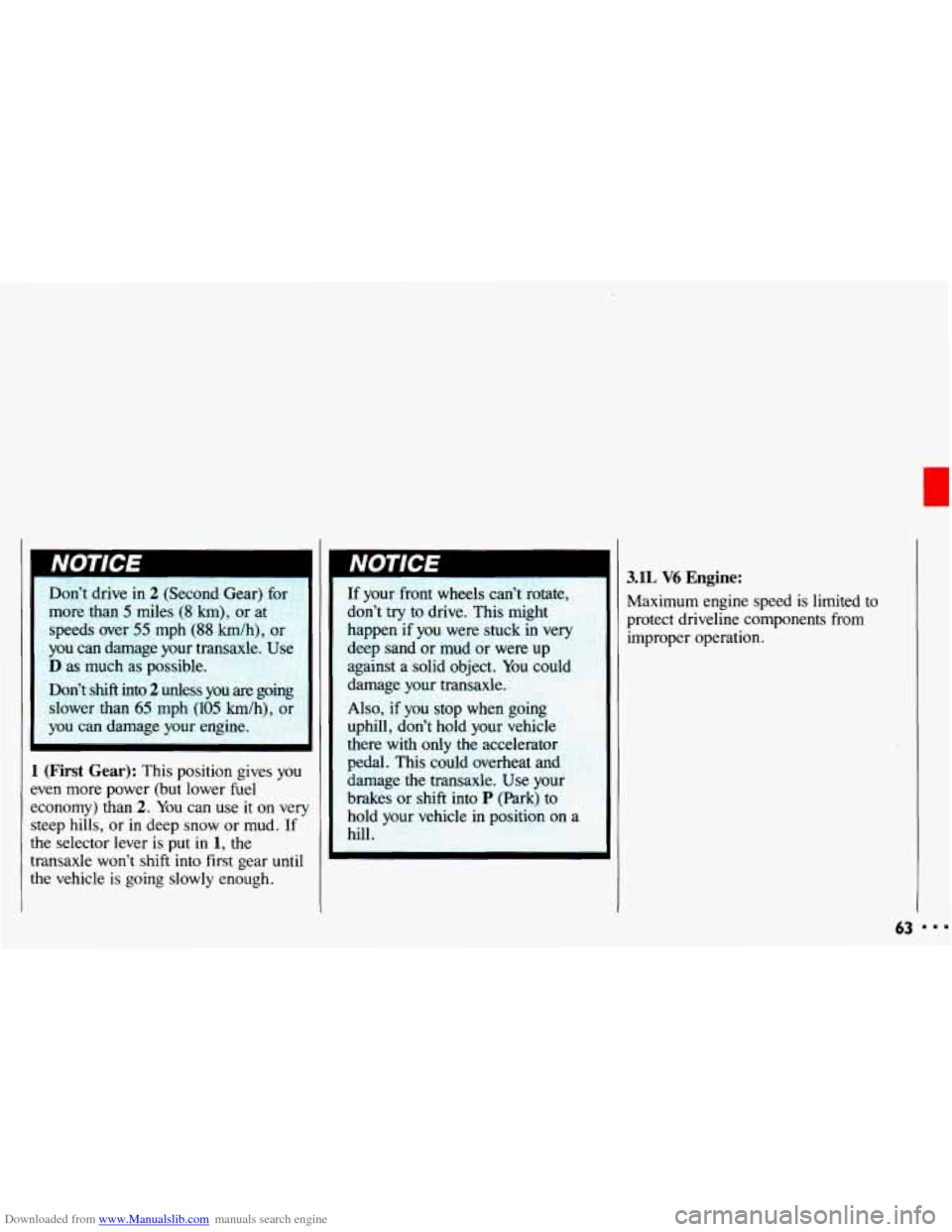
Downloaded from www.Manualslib.com manuals search engine Don’t drive in 2 (Second Gear) fo
more than 5 miles (8 km), or at
speeds over
55 mph (88 km/h), or
you can damage your transaxle. U!
D as much as possible.
Don’t
shift into 2 unless you are going
slower than
65 mph (105 km/h),
you can damage your engine.
r I
1 (First Gear): This position gives you
even more power (but lower fuel II
If your front wheels can’t rotate,
don’t try to drive. This might
happen if
you were stuck in very
deep sand or mud or were up
against a solid object.
aula
damage your transal-’
Also, if you stop when going
uphill, don’t hold your vehicle
there with only
the accelerator
-
pedal. This cduld overheat and
damage the transaxle.
Use your
brakes or shift into
P (Park) to
hold lr vehicle
in position on a
hill.
economy)
than 2. You can use it crh very
steep hills, or in deep snow or mud. If
the selector lever is put in 1, the
transaxle won’t shift
into first gear until
the vehicle is going slowly enough.
3.lL V6 Engine:
Maximum engine speed is limited to
protect driveline components from
improper operation.
Page 69 of 308
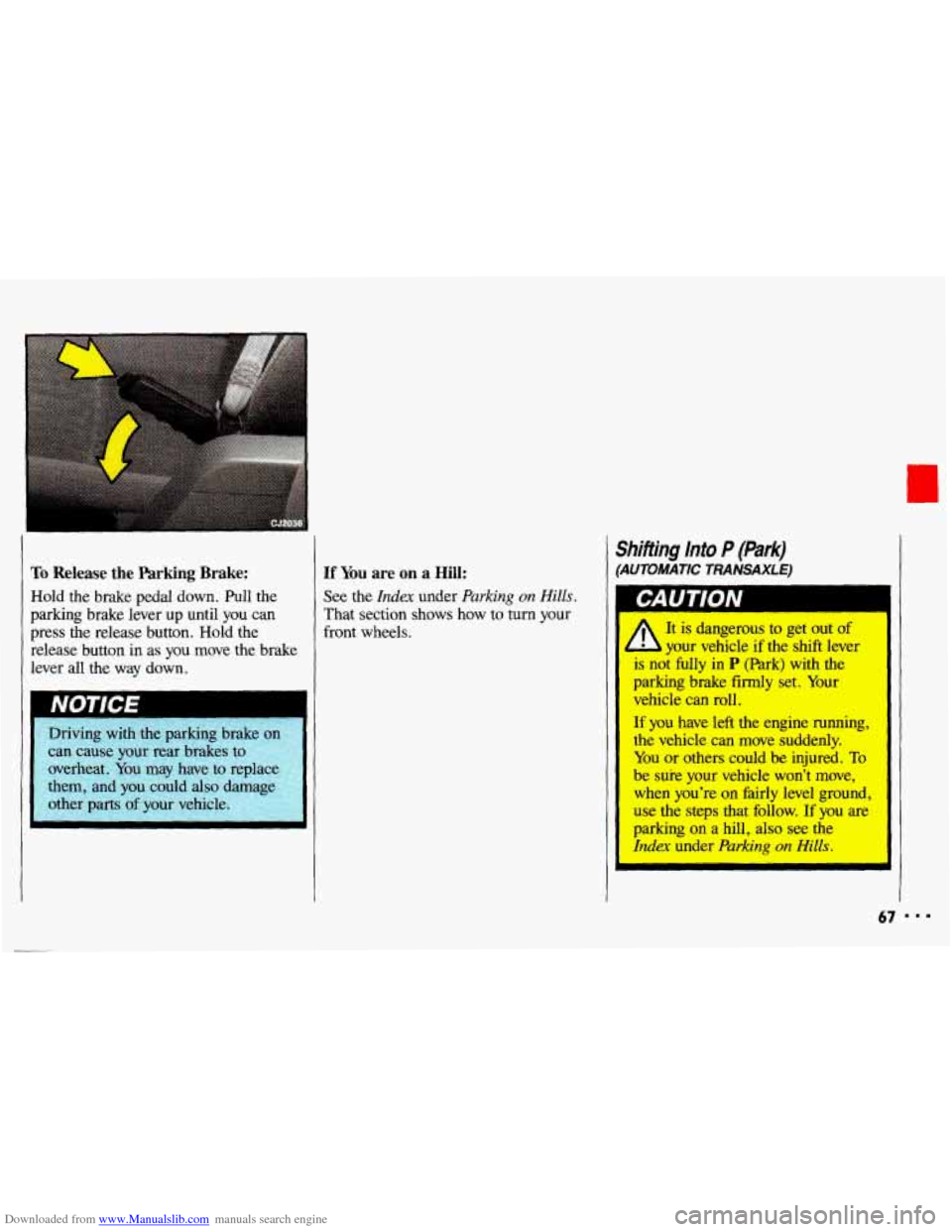
Downloaded from www.Manualslib.com manuals search engine To Release the Parking Brake:
Hold the brake pedal down. Pull the
parking brake lever up until you can
press the release button. Hold the
release button in as you move the brake
lever all the way down.
Driving with the parking brake on
I
can cause your rear brakes to
overheat.
You may have to replam
them, and
you could also dama
other parts
of your vehicle.
J
If You are on a Hill:
See the Index under Parking on Hills.
That section shows how to turn your
front wheels.
Shifting Into P (Park)
(AUTOMATIC TRANSAXLE)
A
It is dangerous to get out of
your vehicle if the shift lever
is not fully in
P (Park) with the
parking brake firmly set. Your
vehicle can roll.
If you have left the engine running,
the vehicle can move suddenly.
You or others could be injured. To
be sure your vehicle won’t move,
when you’re on fairly level ground,
use the steps that follow.
If you are
parking on a hill, also
see the
Index under Parking on Hills.
67
Page 71 of 308
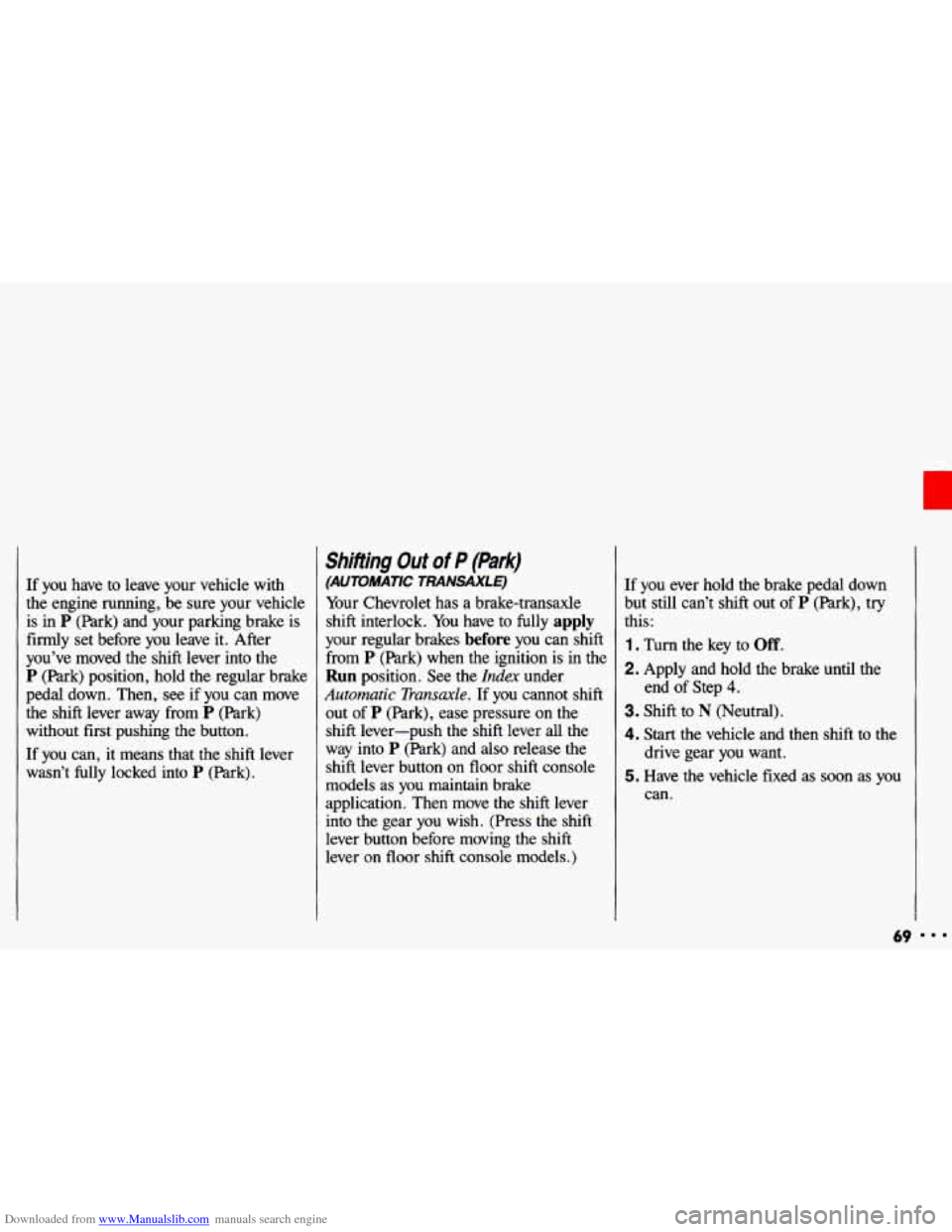
Downloaded from www.Manualslib.com manuals search engine If you have to leave your vehicle with
the engine running, be sure your vehicle is in
P (Park) and your parking brake is
firmly set before you leave it. After
you’ve moved the shift lever into the
P (Park) position, hold the regular brake
pedal down. Then, see if you can move
the shift lever away from
P (Park)
without first pushing the button.
If you can, it means that the shift lever
wasn’t fully locked into
P (Park).
Shifting Out of P (Park)
(AUTOMATIC TRANSAXLE)
Your Chevrolet has a brake-transaxle
shift interlock. You have to fully
apply
your regular brakes before you can shift
from
P (Park) when the ignition is in the
Run position. See the Index under
Automatic Transu.de. If you cannot shift
out
of P (Park), ease pressure on the
shift lever-push the shift lever all
the
way into P (Park) and also release the
shift lever button on floor shift console
models as you maintain brake
application. Then move the shift lever
into the gear
you wish. (Press the shift
lever button before moving the shift lever on floor shift console models.) If you ever hold the brake pedal
down
but still can’t shift out of
P (Park), try
this:
1. Turn the key to Off.
2. Apply and hold the brake until the
3. Shift to N (Neutral).
4. Start the vehicle and then shift to the
drive gear you want.
5. Have the vehicle fixed as soon as you
can. end
of Step 4.
69
Page 76 of 308
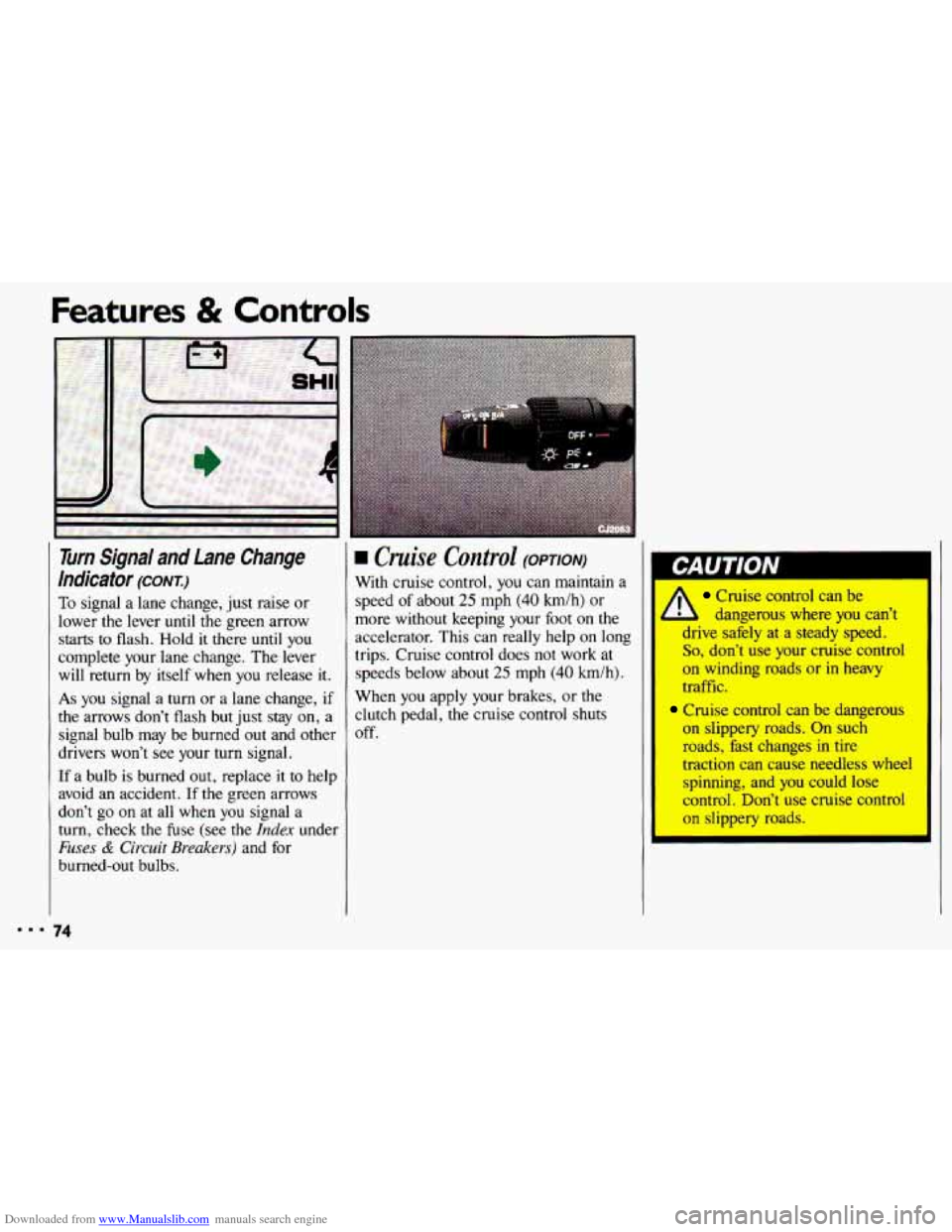
Downloaded from www.Manualslib.com manuals search engine Features & Controls
Turn Signal and Lane Change
Indicator
(CONI)
To signal a lane change, just raise or
lower the lever
until the green arrow
starts to flash. Hold it there until you
complete your lane change. The lever
will return by itself when you release it.
As you signal a turn or a lane change, if
the arrows don’t flash but just stay on, a
signal bulb may be burned out and other
drivers won’t see your turn signal.
If a bulb is burned out, replace it to help
avoid an accident.
If the green arrows
don’t go
on at all when you signal a
turn, check the fuse (see
the Index under
Fuses & Circuit Breakers) and for
burned-out bulbs.
74
rn Cruise Control (OPTION)
With cruise control, you can maintain a
speed of about
25 mph (40 h/h) or
more without keeping your foot on the
accelerator. This can really help on long
trips. Cruise control does not work at
speeds below about
25 mph (40 km/h).
When you apply your brakes, or the
clutch pedal, the cruise control shuts
off.
Cruise control can be
l dangerous where you can’t
drive safely at a steady speed.
So, don’t use your cruise control
on winding roads or-in heavy
traffic.
Cruise control can be dangerous
on slippery roads. On such
roads, hst changes in
tire
traction can cause needless wheel
spinning, and you could
lose
control. Don’t use cruise control
on slippery roads.
Page 103 of 308
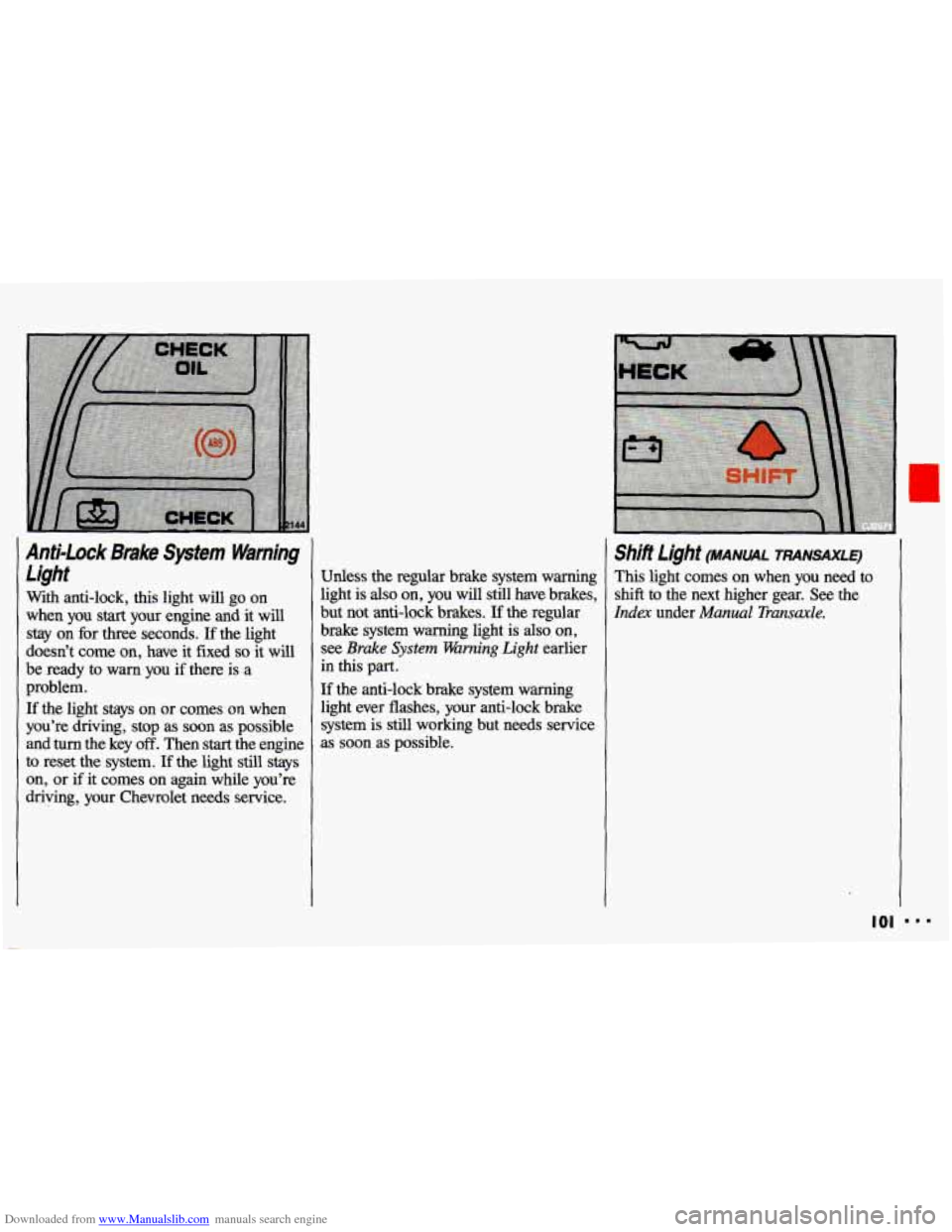
Downloaded from www.Manualslib.com manuals search engine Anti-Lock Brake System Warning
Light
With anti-lock, this light will go on
when you
start your engine and it will
stay on for three seconds.
If the light
doesn’t come on, have it fixed
so it will
be ready to warn you if there is a
problem.
If the light stays on or comes on when
you’re driving, stop as soon as possible
and turn the key
off. Then start the engine
to reset the system.
If the light still stays
on, or if it comes on again while you’re
driving, your Chevrolet
needs service.
Shift light (MANUAL TRANSAXLE)
Unless the regular brake system warning
brake system warning light is
also on,
Index under Manual Transale. but not anti-lock brakes. If the regular shift to the next higher gear. See
the
light is
also on, you will still have brakes, This
light comes on when you need to
in this part.
see Brake System Warning Light earlier
If the anti-lock brake system warning
light ever flashes, your anti-lock brake
system is still working but needs service
as soon as possible.
IO1